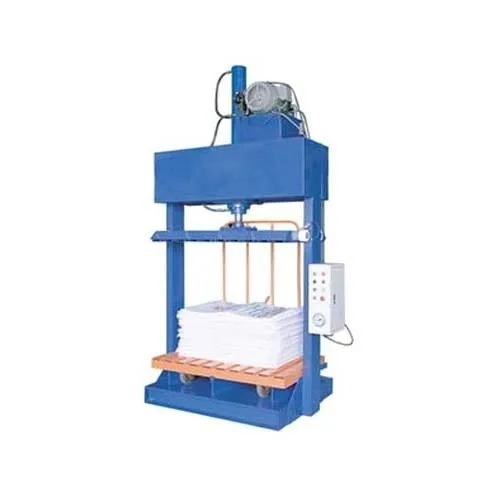Baling press machine, commonly known as balers, play an essential role in waste management and recycling industries. They compress materials like paper, plastic, metals, and textiles into compact, manageable bales, facilitating easy handling, transportation, and storage. As global waste generation continues to rise, the importance of efficient baling press machines has grown significantly. This article explores the types, functions, and benefits of baling press machines, along with innovations and future trends in the industry.
The Importance of Baling Press Machine
Baling press machines are indispensable in various sectors due to their ability to streamline waste management processes. They help in:
- Reducing Waste Volume: By compressing bulky materials into dense bales, balers significantly reduce the volume of waste, making it easier to handle and transport.
- Facilitating Recycling: Balers prepare recyclable materials for further processing, ensuring that they are in a form suitable for recycling facilities.
- Cost Savings: Reducing the volume of waste lowers transportation and storage costs, providing economic benefits to businesses and waste management companies.
- Environmental Protection: Efficient waste compaction and recycling reduce landfill use, lower greenhouse gas emissions, and conserve natural resources.
Types of Baling Press Machine
Baling press machines come in various types, each designed for specific materials and applications. The main categories include:
- Vertical Balers: These machines are ideal for small to medium-sized operations. They occupy less floor space and are typically used for materials like cardboard, paper, and plastics. Vertical balers are manually loaded and produce smaller bales compared to horizontal balers.
- Horizontal Balers: Suitable for high-volume operations, horizontal balers handle a wide range of materials, including cardboard, plastics, metals, and textiles. They are automatically or semi-automatically loaded and produce larger, more consistent bales. Horizontal balers can be further divided into closed-end and open-end balers based on their configuration.
- Two-Ram Balers: Featuring two hydraulic rams, these balers offer higher compression force and are ideal for processing dense materials like metals. They provide flexibility in handling different materials without the need for pre-sorting.
- Single-Ram Balers: With a single hydraulic ram, these balers are suitable for less dense materials. They are often used in facilities where space is limited and the volume of waste is moderate.
- Automatic Tie Balers: Designed for high-efficiency operations, these balers automatically tie bales with wire or plastic straps, reducing labor costs and increasing throughput.
- Specialty Balers: These include balers designed for specific materials, such as tire balers, textile balers, and drum crushers. They cater to niche markets with unique waste management needs.
Functions and Operation of Baling Press Machine
Baling press machines operate through a series of steps to compress and bind materials into bales:
- Loading: Materials are loaded into the baler’s chamber, either manually or automatically, depending on the type of baler.
- Compression: Hydraulic or pneumatic systems apply pressure to compress the materials into a dense block. The compression force varies based on the material and the type of baler.
- Bale Formation: Once the desired density is achieved, the compressed material is formed into a bale. Horizontal balers typically have a continuous feeding mechanism, while vertical balers compress materials in batches.
- Tying and Ejection: The compressed bale is tied with wire, plastic straps, or other binding materials to maintain its shape. Automatic tie balers perform this task without manual intervention. The finished bale is then ejected from the chamber, ready for storage or transportation.
Benefits of Baling Press Machine
The use of baling press machines offers numerous advantages:
- Space Efficiency: By reducing the volume of waste, balers free up valuable floor space in facilities, allowing for better utilization of available area.
- Improved Safety: Compact bales are easier to handle and transport, reducing the risk of accidents and injuries associated with bulky waste materials.
- Enhanced Recycling Rates: Properly baled materials are more likely to be accepted by recycling facilities, promoting higher recycling rates and contributing to a circular economy.
- Operational Efficiency: Automating the baling process reduces labor costs and increases throughput, enhancing overall operational efficiency.
- Economic Benefits: Reduced transportation and storage costs, along with potential revenue from selling recyclable materials, contribute to significant economic benefits for businesses.
Innovations and Future Trends in Baling Press Machine
The baling press machine industry is continuously evolving, driven by technological advancements and changing market demands. Key innovations and future trends include:
- Automation and Smart Technology: The integration of automation and smart technology is revolutionizing baler operations. Features like automatic loading, tying, and bale ejection, along with IoT-enabled monitoring systems, enhance efficiency and reduce labor costs.
- Energy Efficiency: Newer baler models are designed to be more energy-efficient, reducing operational costs and environmental impact. Hydraulic systems with variable frequency drives (VFDs) and energy-efficient motors are becoming standard.
- Material Versatility: Innovations in baler design are expanding the range of materials that can be effectively baled. This includes advancements in handling lightweight and difficult-to-compact materials like foam and film plastics.
- Sustainability: The push for sustainable waste management practices is driving the development of balers that minimize environmental impact. This includes using eco-friendly materials for construction and incorporating features that enhance recyclability.
- Customization and Modularity: Manufacturers are offering customizable and modular baler solutions to meet the specific needs of different industries. This flexibility allows businesses to tailor baler configurations to their unique waste streams.
Conclusion
Baling press machine is essential tools in modern waste management and recycling operations. They offer numerous benefits, including space efficiency, improved safety, enhanced recycling rates, and economic advantages. As the industry continues to evolve, innovations in automation, energy efficiency, material versatility, sustainability, and customization will further enhance the capabilities and applications of baling press machines. By investing in advanced baler technology, businesses can improve their waste management practices, contribute to environmental sustainability, and achieve significant cost savings.



